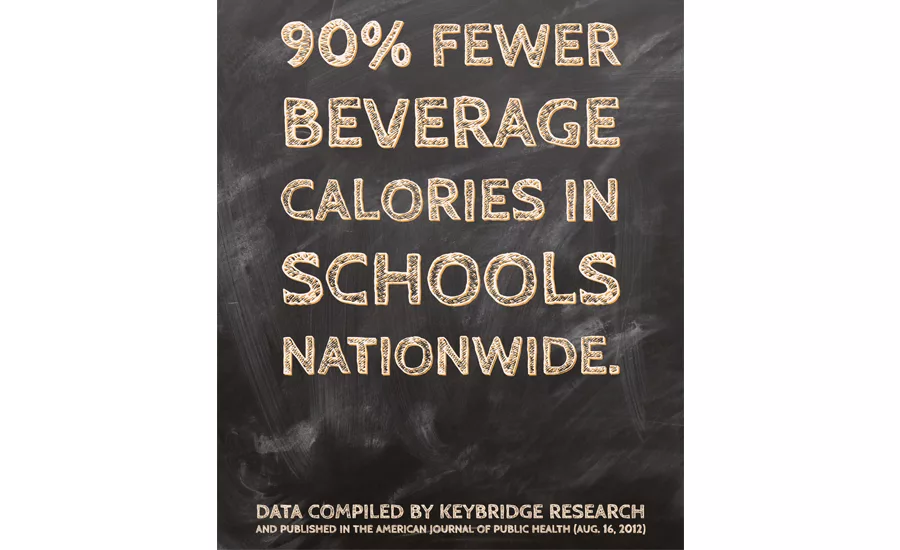Beverage calories in schools reduced by 90 percent
Clearer packaging labels focus of beverage vending program

This fall, as children are heading back to school, the institutions that participate in the federal lunch program will continue to ensure that children and teens will be receiving healthier food, snack and beverage choices, experts note.
Now in its third year, the U.S. Department of Agriculture (USDA) has been implementing its Smart Snacks in School standards. Working in partnership with government entities, school partners, associations and parents, a 90 percent reduction in beverage calories in schools has been achieved since the standards were initiated — largely by limiting the sale of sugary beverages and serving smaller portions, they add.
For example, the USDA’s website states that elementary schools can sell up to 8-ounce portions of unflavored low-fat milk, flavored or unflavored non-fat milk and milk alternatives, 100 percent fruit or vegetable juices, and 100 percent fruit or vegetable juices diluted with water and no added sweeteners. Middle schools and high schools can sell beverage serving sizes of up to 12-ounces.
“The Smarts Snacks in School nutrition standards will help schools to make the healthy choice the easy choice by offering more of the foods and beverages we should be encouraging — whole grains, fruits and vegetables, leaner protein, low-fat dairy, while limiting foods with too much sugar, fat and salt,” the website states. It also showcases a new tag line proclaiming, “the School Day just got Healthier.”
The Washington, D.C.-based American Beverage Association (ABA), the National Harbor, Md.-based School Nutrition Association and First Lady Michelle Obama’s Let’s Move and Drink Up campaigns also are fostering the push to eliminate obesity and help families live healthier lifestyles, according to experts.
“Parents, especially moms, like the Smarts Snacks in School program because it supports their efforts to teach their children how to lead a balanced lifestyle,”
says ABA’s President and Chief Executive Officer Susan Neely. “… As a mom herself, the First Lady … talks about balancing calories consumed with exercise and figuring out when a treat, like a full-calorie soft drink, is in order.
“The Drink Up initiative promotes water consumption, but does not denigrate other beverage choices,” she continues. “That philosophy of balancing choices is consistent with the beverages and snacks now sold in schools, along with other initiatives to ensure students are learning about good nutrition, the importance of exercise and how to lead a balanced lifestyle.”
When the ABA successfully implemented the School Beverage Guidelines, an 88 percent reduction in beverage calories shipped to schools had been achieved, according to Neely, who notes that today, this number now is greater than 90 percent.
Neely adds that the changes within schools also is a reflection of the overall beverage market. “Let’s be clear, we still provide beverage options in schools that have calories, but they are capped. … There has been significant innovation in what is offered in the school environment, providing students and parents with more lower-calorie and smaller-portion choices than ever before — and this is what is happening in the broader marketplace as well.”
The cut in beverage calories has been achieved by “drastically changing what could be sold a la carte and in vending machines in schools,” says Diane Pratt-Heavner, media relations’ director at the School Nutrition Association, National Harbor, Md.
Yet, she notes that food and beverage companies have risen to the challenge by introducing a number of compliant beverages to appeal to students’ tastes.
For example, Sunny Delight Beverages Co., Cincinnati, Ohio, the Atnip Company, Fullerton, Calif., and Juice Alive, Katy, Texas, were among more than 400 companies showcasing their better-for-you products at the association’s July 70th Annual National Conference in San Antonio, Texas.
Calorie label awareness
Experts note that public-private partnerships, along with support and compliance from consumers, are key components to addressing complex societal issues, including childhood obesity.
To help raise awareness, the ABA’s Clear on Calories program displays calorie labels on the front of every can, bottle and package, making transparent, fact-based information accessible for consumers, the company says.
With a goal to reduce beverage calories by 20 percent by 2025 for all consumers, the ABA is collaboratively working with several leading beverage companies, including The Coca-Cola Co., Atlanta; Dr Pepper Snapple Group, Plano, Texas; and PepsiCo Inc., Purchase, N.Y., to reach consumers where they purchase their beverages.
“More than three million pieces of company-controlled equipment will provide calorie-counts and calorie-awareness messages to remind people to ‘Check then Choose’ or to ‘Balance What They Eat, Drink & Do.’” Neely says. “These same companies are also leveraging their strengths in product innovation, marketing and distribution … to provide Americans with a wider range of options — from flavors to sweeteners to calorie ranges and portion sizes.”
ABA notes that the schools channel is benefiting from innovative new products and packaging sizes.
“The beverage industry is in a new age, one in which every American will find something in the beverage aisle that they enjoy and can help them achieve their own balance,” Neely says. “We are excited to see what the future has in store for our industry and our consumers.”
Looking for a reprint of this article?
From high-res PDFs to custom plaques, order your copy today!


